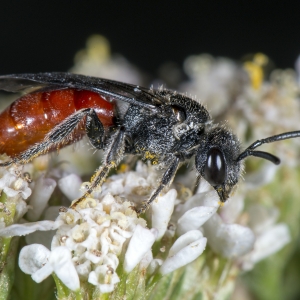Uncategorized
MSU professor creates online photobook of regional insects
Published
8 years agoon
Posted By
Outlaw Partners

This is a sweat bee, probably in the genus Sphecodes. Bees in this genus, characterized by their bright red abdomens, are parasites of other bees. PHOTO COURTESY OF ROBERT PETERSON
BOZEMAN – A Montana State University professor has created a way for people across Montana and beyond to access photos of an often unseen world.
Robert Peterson, professor in MSU’s Department of Land Resources and Environmental Sciences in the College of Agriculture, has created an online collection of his photos showcasing the insect world of the Greater Yellowstone Ecosystem. Peterson hopes the online photobook—which includes more than 120 images taken over a period of 14 years—will be used and appreciated by the public.
“There’s an entire, hidden world beneath our feet that’s not well understood or appreciated,” Peterson said. “Insects are the most abundant and diverse multicellular organisms in the GYE, and they play a vital role in how ecosystems function, but because they are small and people rarely see them close up, they’re overlooked in regard to their importance.”
The website, Insects of the Greater Yellowstone Ecosystem, currently features close-up images showcasing the bright colors, delicate features and habitats of regional butterflies and moths, beetles, flies, bees, wasps, ants, sawflies, grasshoppers and other types of insects. Scientific names of the insects are listed, as is brief information about the insects’ anatomy, behavior and habitat.
The GYE includes Yellowstone National Park, comprises 34,375 square miles, and is one of the largest nearly intact temperate-zone ecosystems on Earth, according to the National Park Service. Peterson said at least two out of every three species is an insect within this ecosystem.
“Their diversity and abundance is staggering,” he said. “Insects aren’t viewed as charismatic as some of the large mammals in the region, but they are critical to any healthy ecosystem because they serve as pollinators that stimulate plant diversity, they’re an important food source for other organisms, they recycle nutrients, and are a crucial foundation for watershed health.”
The project includes a Facebook and Twitter page as well, where Peterson posts pictures and descriptions of insects. Photographs of insects can be added indefinitely because there are thousands of species in the GYE, giving scientists plenty of insects to photograph.
Eventually, Peterson hopes to incorporate images from other photographers and encourage novice entomologists to explore, identify and share findings.
“The ultimate goal is to develop an appreciation, support education and spur an awareness of this hidden world,” he said. “You don’t have to go to far-flung places to study insects; there’s a jungle right outside your backdoor.”
The Outlaw Partners is a creative marketing, media and events company based in Big Sky, Montana.


Upcoming Events
april, 2024
Event Type :
All
All
Arts
Education
Music
Other
Sports
Event Details
Saturday, March 23rd 6:00-8:00pm We will combine the heart-opening powers of cacao with the transcendental powers of breathwork and sound. Together, these practices will give us the opportunity for a deep
more
Event Details
Saturday, March 23rd 6:00-8:00pm
Time
March 23 (Saturday) 6:00 pm - April 23 (Tuesday) 8:00 pm
Location
Santosha Wellness Center
169 Snowy Mountain Circle
Event Details
We all are familiar with using a limited palette, but do you use one? Do you know how to use a
more
Event Details
We all are familiar with using a limited palette, but do you use one? Do you know how to use a limited palette to create different color combinations? Are you tired of carrying around 15-20 different tubes when you paint plein air? Have you ever wanted to create a certain “mood” in a painting but failed? Do you create a lot of mud? Do you struggle to achieve color harmony? All these problems are addressed in John’s workbook in clear and concise language!
Based on the bestselling “Limited Palatte, Unlimited Color” workbook written by John Pototschnik, the workshop is run by Maggie Shane and Annie McCoy, accomplished landscape (acrylic) and plein air (oil) artists,exhibitors at the Big Sky Artists’ Studio & Gallery and members of the Big Sky Artists Collective.
Each student will receive a copy of “Limited Palette, Unlimited Color” to keep and take home to continue your limited palette journey. We will show you how to use the color wheel and mix your own clean mixtures to successfully create a mood for your paintings.
Each day, we will create a different limited palette color chart and paint a version of a simple landscape using John’s directives. You will then be able to go home and paint more schemes using the book for guidance.
Workshop is open to painters (oil or acrylic) of any level although students must have some basic knowledge of the medium he or she uses. Students will be provided the book ($92 value), color wheel, value scale and canvas papers to complete the daily exercises.
Sundays, April 14, 21 and 28, 2024
Noon until 6PM.
$170.
Time
14 (Sunday) 12:00 pm - 28 (Sunday) 6:00 pm
Event Details
Trivia from 7 to 9 p.m. at The Waypoint in Town Center. Participation is free, food and beverages available.
Event Details
Trivia from 7 to 9 p.m. at The Waypoint in Town Center. Participation is free, food and beverages available.
Time
(Wednesday) 7:00 pm - 9:00 pm
Location
The Waypoint
50 Ousel Falls Rd










